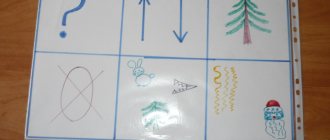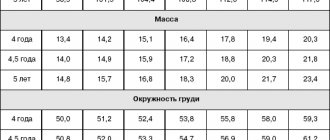Formation of the grammatical structure of speech in preschoolers; educational and methodological material on the topic
Formation of grammatical structure of speech in preschool children
1. The grammatical structure of the native language, the importance of its acquisition for the speech development of children.
2. Features of children’s acquisition of the grammatical structure of the Russian language.
3. The main periods of formation of the grammatical structure of speech.
4. Ways to form the grammatical aspect of speech in children.
5. Tasks for the formation of the grammatical aspect of speech in children.
6. Methods and techniques for the formation of the grammatical structure of speech.
Grammar is the science of the structure of language, its laws. It combines word formation, morphology, and syntax. Morphology studies the grammatical properties of a word and its form, grammatical meanings within a word; syntax - phrases and sentences, compatibility and word order; word formation - the formation of a word on the basis of another cognate word with which it is motivated.
Mastering the grammatical structure of a language is of great importance, since only morphologically and syntactically formalized speech can be understood by the interlocutor and can serve as a means of communication with adults and peers.
Mastering the grammatical norms of a language contributes to the fact that the child’s speech begins to perform, along with the function of communication, the function of a message when he masters the monologue form of coherent speech. Syntax plays a special role in the formation and expression of thought, i.e. in the development of coherent speech. Mastering grammatically correct speech affects the child’s thinking. He begins to think more logically, consistently, generalize, distract from the specific, and correctly express his thoughts. Mastery of grammatical structure has a huge impact on the overall development of the child, ensuring the transition to language learning at school. The formed grammatical structure of speech is an indispensable condition for the successful and timely development of monologue speech - one of the leading types of speech activity.
The development of grammatical structure is the key to successful general speech training, ensuring practical mastery of the phonetic, morphological and lexical levels of the language system. The formation of grammatical skills has a positive effect on the increase in children’s volitional factor in statements, creates the prerequisites for the emergence of the planning function of speech, for the introduction of the concept of norms - “possible”, “impossible”, “right”, “wrong”. A child who has a developed grammatical structure of speech is emotionally healthy: he is not constrained in communicating with peers, is not shy, and fearless in speech statements, in expressing his own thoughts, feelings, and moods; he painlessly joins the school community and feels like a full and equal participant in collective activities. In kindergarten, the task is not to study the laws of grammar, become familiar with its categories and terminology. Children learn the rules and laws of language through the practice of live speech. In preschool age, a child needs to develop the habit of speaking grammatically correctly.
FEATURES OF CHILDREN'S ACQUISITION OF THE GRAMMARAL STRUCTURE OF THE RUSSIAN LANGUAGE.
The process of a child’s assimilation of grammatical structure is complex; it is associated with the analytical and synthetic activity of the cerebral cortex. The mechanism of development of this complex mental activity was revealed by I.P. Pavlov, who expressed the idea that grammar is a unique form of dynamic speech stereotype. Physiology has established a conditioned reflex basis for mastering the grammatical aspect of speech. The child develops a certain dynamic stereotype when changing nouns, adjectives and other grammatical forms. The child learns that expressing certain thoughts requires the use of certain grammatical forms. The development of a dynamic stereotype is facilitated by its great stability. If a child has mastered case endings, he uses them accurately. However, throughout preschool age, imperfections in both the morphological and syntactic aspects of speech are observed. Only by the age of eight can we talk about the child’s complete assimilation of the grammatical structure of the language. The patterns of mastering the grammatical aspect of speech were revealed by the famous linguist Alexander Nikolaevich Gvozdev. His research contains enormous factual material from long-term observations of the process of morphological and syntactic formation of children's speech, which makes it possible to trace the process of formation of grammatical structure.
Famous linguist A.N. Gvozdev outlined the MAIN PERIODS in the formation of the grammatical structure of the Russian language.
FIRST PERIOD – the period of sentences consisting of amorphous root words, which are used in one unchanged form in all cases when they are used (from 1 year 3 months to 1 year 10 months).
SECOND PERIOD – the period of mastering the grammatical structure of a sentence, associated with the formation of grammatical categories and their external expression (from 1 year 10 months to 3 years).
THIRD PERIOD – the period of assimilation of the morphological system of the Russian language, characterized by the assimilation of types of declensions and conjugations (from 3 to 7 years).
The difficulties and gradualness of mastering the grammatical structure are explained by several reasons: characteristics of age, patterns of mastering the morphological and syntactic aspects of speech, the complexity of the grammatical system, especially morphology. The most typical morphological errors in children's speech:
– incorrect endings of nouns (plural genitive with the ending – her: pencils, hedgehogs, doors, floors; with a zero ending – nights, girls, doors, dolls, books, buttons; singular genitive: at the doll, at the sister, at mom's, without a spoon; accusative case of animate and inanimate nouns: dad gave me a baby elephant, Seryozha caught a catfish; prepositional case of inanimate masculine nouns: in the forest, in the garden, in the nose;
– declension of indeclinable nouns: on palta, on piano, kofiya, kofiya, in kine;
– formation of the plural of nouns denoting young animals: lambs, foals, kittens, pigs;
– change of gender of nouns: big apples, buy ice cream, dad left, warm milk, green dress;
– formation of verb forms (imperative mood: seek, sing, gallop, ride, fold; changing the stem of the verb: seek – I’m looking, cry – I’m crying, I can – I can, splash – I’m splashing, draw – I’m drawing;
- conjugation of verbs: want - want (want), eat - eat (eat), give - give (give), sleep - spit (sleep);
– incorrect form of participles: broken, sewn, torn;
– formation of the comparative degree of the adjective: brighter, worse, bad, cleaner, more beautiful;
– ending pronouns in indirect cases: my ears hurt, in this pocket, you have a new dress;
– declension of numerals: two houses, go two by two, with two.
In the study of the grammatical structure of speech of preschool children A.G. Arushanova identifies several areas.
THE FIRST DIRECTION is related to the correction (prevention) of inaccuracies and errors characteristic of children (verb conjugation, plural and gender of nouns, etc.).
SECOND DIRECTION – identifying the essential links in the mechanism of children’s mastery of grammatical structure, developing an understanding of grammatical forms, forming grammatical generalizations, their abstraction and transfer to new areas of reality.
THE THIRD DIRECTION is associated with identifying the pedagogical conditions for the formation of the mechanism of grammatical structuring in the field of syntax and word formation.
WAYS FOR FORMING THE GRAMMATIC ASPECT OF SPEECH IN CHILDREN. The ways of forming grammatically correct speech are determined on the basis of knowledge of the general patterns of speech development, studying the grammatical skills of children in this group and analyzing the causes of their grammatical errors.
Ways to form grammatically correct speech:
1. Creation of a favorable language environment that provides examples of literate speech; improving the speech culture of adults;
2. Special teaching of difficult grammatical forms for children, aimed at preventing mistakes.
3. Formation of grammatical skills in the practice of verbal communication.
4. Correction of grammatical errors.
The successful formation of grammatically correct speech is possible provided that the causes of children's errors in the field of grammar are understood and taken into account when choosing methods and techniques of work.
Grammatical errors of preschoolers are determined by various factors:
– general psychophysiological patterns of child development (development of attention, memory, thinking, state of nervous processes);
-difficulties in mastering the grammatical structure of the language and the level of its development;
– stock of knowledge about the world around us and the volume of the vocabulary;
– the state of the speech apparatus and the level of development of phonemic speech perception;
– unfavorable influence of the surrounding speech environment;
– pedagogical neglect;
– insufficient attention to children’s speech on the part of adults.
Creating a favorable language environment is one of the conditions for children’s literate speech. Due to great imitation, a child borrows from adults not only correct, but also erroneous forms of words, speech patterns, and communication style in general.
THE MAIN TASKS IN FORMING THE GRAMMARAL ASPECT OF SPEECH IN CHILDREN are considered in three directions:
1. Help children practically master the morphological system of their native language (variation by gender, number, person, tense).
2. Help children master the syntactic side: teach the correct agreement of words in a sentence, constructing different types of sentences and combining them in a coherent text.
3. Provide knowledge about some norms for the formation of word forms - word formation.
These tasks are implemented in a complex, in connection and interaction with the solution of other speech tasks. The system of inflection is mastered at a young and middle age, the system of word formation - starting from the middle group. In the middle and senior groups, the process of forming word-formation skills is characterized by intensity and creativity. In the preparatory group for school, knowledge of the norms of word formation begins to develop. There are several stages in the acquisition of grammatical means and methods of language:
– first, children are given the task of understanding the meaning of what is being said (focusing on the ending of the noun, distinguishing where there is one object and where there are many);
– further – use one or another grammatical device in your speech, speak as others speak, borrow a grammatical form from the speech of others;
- a more difficult task is to independently form forms of a new word by analogy with a familiar one (foals, bear cubs by analogy with the word form - kittens);
- and, finally, a more difficult task - to evaluate the grammatical correctness of your own and other people's speech, to determine whether it is possible or impossible to say so.
METHODS AND TECHNIQUES.
Methods include didactic games, dramatization games, verbal exercises, looking at pictures, retelling short stories and fairy tales.
These methods can also act as techniques when using other methods. Didactic games and dramatization games are carried out with children of primary and middle age. Exercises - mainly with children of older preschool age. Didactic games are an effective means of consolidating grammatical skills, since thanks to the dynamism, emotionality and interest of children, they make it possible to practice the child many times in repeating the necessary word forms. Didactic games can be carried out with toys, objects and pictures, as well as in the form of word games. For each didactic game, the program content is clearly defined. Mandatory requirements for visual material: it must be familiar to children, aesthetically designed, evoke specific images, and awaken thought. Dramatization games are distinguished by the fact that they play out scenes (mini-performances) with toys. At first, the director is the teacher himself, later - the child, for example, in the game “Doll's Birthday”.
E.I. Tikheyeva developed exercises for the development of speech of preschoolers, including for the development of its syntactic side: for the spread of sentences, for adding subordinate clauses. Examination of paintings, mainly plot ones, is used to develop the ability to construct simple and complex sentences. Retelling short stories and fairy tales is a valuable tool for teaching children how to construct sentences, since the work of fiction itself is an example of grammatically correct speech.
A.M. Borodich identifies active teaching methods that prevent the occurrence of errors, concentrating children's attention on the correct word form and phrase. At the initial stage, the leading role is played by the teacher’s speech sample. A direct instruction is possible, highlighting a difficult word from the context, an offer to remember it, to learn to pronounce it correctly.
In older groups, it is appropriate to give a motivation for the learning task: “Come up with sentences with the word piano. Let me remind you that this word is always said the same way: near the piano, two pianos. Remember this. After all, everyone wants to quickly learn how to speak correctly, without mistakes.” When working on correct speech, such effective techniques are used as comparison, correction and hints, creating problematic situations, questions of a prompting and evaluative nature, involving children in correcting mistakes, reminding them how to say correctly, etc.
Formation of word formation skills
The process of dream formation is closely related to morphology. Children's attempts at word creation help the child understand that new words can appear if small changes are made to already familiar words.
Many word formations and inflections occur through the use of prefixes and suffixes. Of course, preschoolers do not know these kinds of structural concepts, but they can intuitively identify the root in a word and use it to get a new word.
The first to be used are suffixes, which make it possible to form diminutive designations. Children have in their active vocabulary the adjectives “pretty”, “smooth”, or the nouns “kitten”, “handkerchief”, etc.
Methods of word formation in preschoolers are often based on the function that the concept denotes. That is, instead of the word “help”, children can use the word “help”. Parents need to be attentive to what words the child uses in his speech, and explain how an object or creature should be called correctly, and correct a number of erroneous forms of verbs and adjectives.






